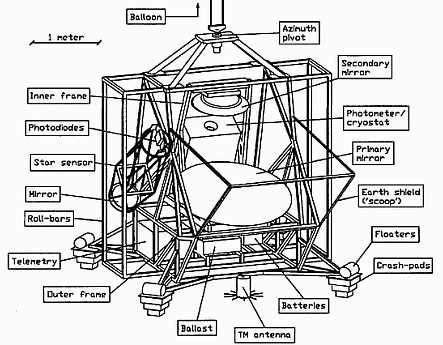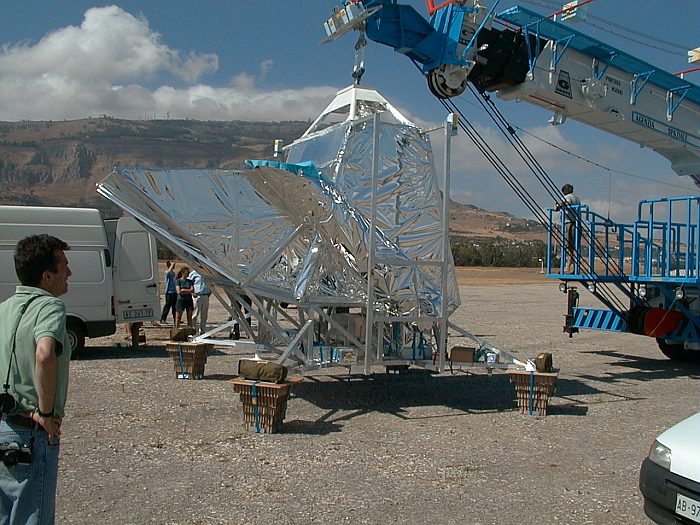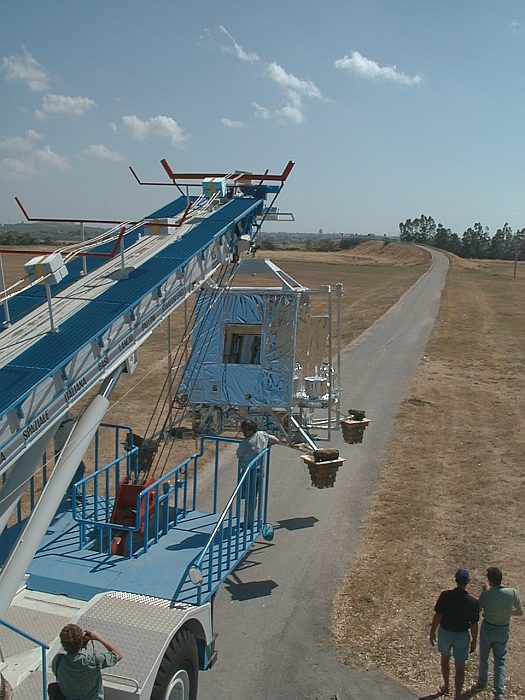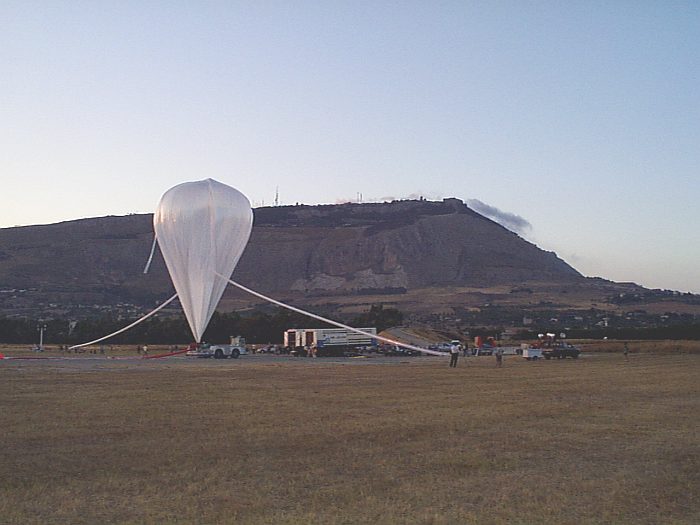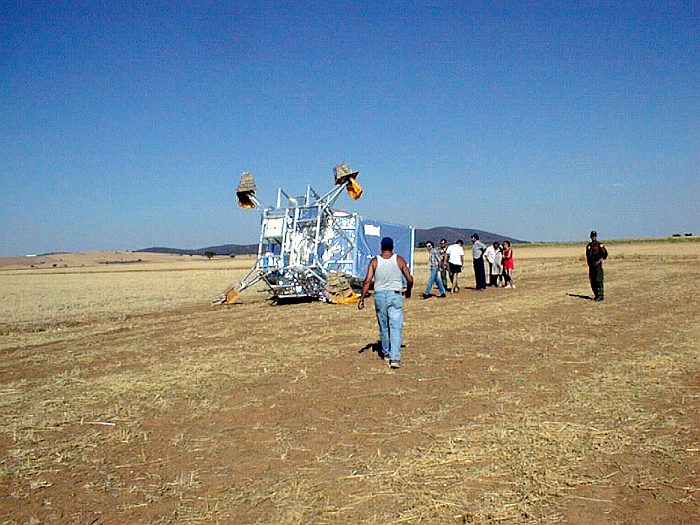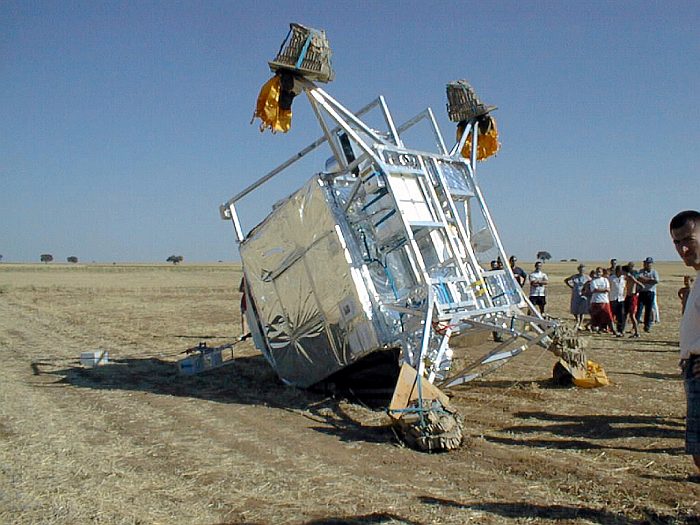Purpose of the flight and payload description
This instrument was designed to measure the anisotropies of the cosmic microwave background and make a map of a large fraction of the sky. To achieve this, the 1.5 meter diameter telescope is suspended from a stratospheric balloon, pointing 45 degrees from vertical, and spun at about 2 revolutions per minute. With this scanning strategy, as much as one-third of the sky can be covered during a 12 hour flight.
The ARCHEOPS experiment provided a crucial and very successful test of several state-of-the-art technologies that will be used on the ESA Planck mission. Planck, which is scheduled to be launched in 2007, is dedicated to making the definitive map of the faint structures imprinted in the Cosmic Microwave Background.
This was a test flight of a basic configuration of the instrument wich used a reduced focal plane (six detectors only, four of which worked satisfactorily).
The main objective was to test the general behaviour of the instrument, and in particular the dilution fridge which had never been flown before. This test was critical not only for future Archeops scientific flights, but also as a feasibility test for some instruments of the Planck mission.
The scientifically useful data ranged from 23.45 UT on the 17th, when the instrument operation parameters were fully adjusted at the nominal flight altitude, until sunrise at 4.00 UT the next day (about four hours of useful data).
Details of the balloon flight
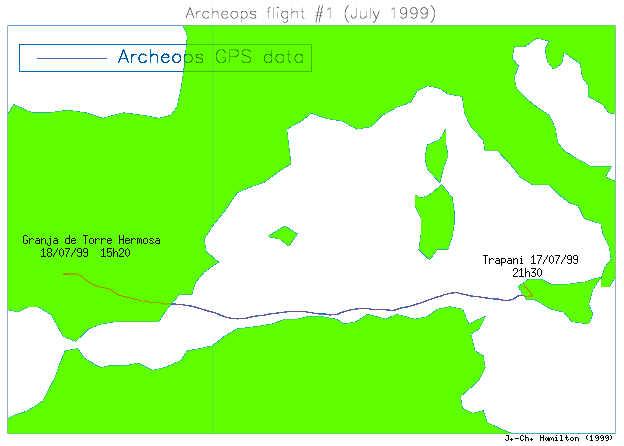
Balloon launched on: 7/17/1999 at 21:22 local
Launch site: Base di Lancio Luigi Broglio, Trapani, Sicily, Italy
Balloon launched by: Agenzia Spaziale Italiana (ASI)
Balloon manufacturer/size/composition: Zero Pressure Balloon
End of flight (L for landing time, W for last contact, otherwise termination time): 7/18/1999 at 14:22 local
Balloon flight duration (F: time at float only, otherwise total flight time in d:days / h:hours or m:minutes - ): ~ 24 hs
Landing site: Near Granja de Torre Hermosa, Badajoz, Spain
The balloon was launched by dinamic method assisted by launch vehicle in the evening of the 17th July 1999 at the end of the scheduled launch window, in particular when the meteorological requirements were met.
The balloon trajectory was nominal for a trans-Mediterranean flight. After take-off from Trapani (Sicily) the balloon achieved float altitude at 1:27 maintaining during the rest of the flight a height of flight of between 40 and 42 kms and grazing the African continent before reaching Spain.
At 14:22 was sent the separation command cuting down the gondola from the balloon, wich descended on parachute and landed near Granja de Torre Hermosa (Badajoz, Spain) at 15:23.
External references
- ARCHEOPS website
- A simple and reliable star sensor for spinning payloads AIP Conference Proceedings 616, 52 (2002)
- An update on Archeops: flights and data products Astrophysics and Space Science, v. 290, Issue 1, p. 119
- Archeops results C. R. Physique 4 (2003)
- Archeops: CMB Anisotropies Measurement from Large to Small Angular Scale COSMO-01 Workshop, Rovaniemi, Finland, 2001
- Preliminary results and perspectives in the Archeops experiment Proceedings to "Les rencontres de Physique de la Vallee d'Aoste", la Thuile, Italy, March 2000
- Transmediterranean flights, in the edge of two centuries Advances in Space Research Volume 33, Issue 10, 2004, Pages 1594-1599
2082If you consider this website interesting or useful, you can help me to keep it up and running with a small donation to cover the operational costs. Just the equivalent of the price of a cup of coffee helps a lot.

